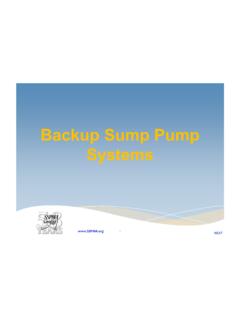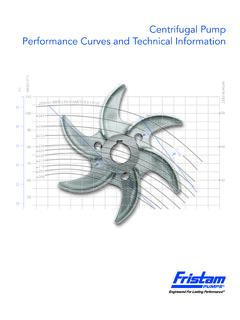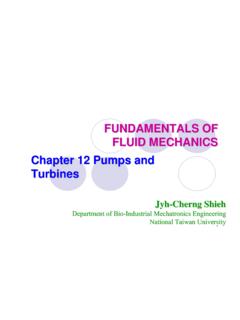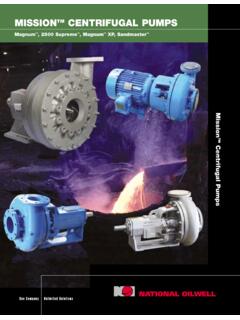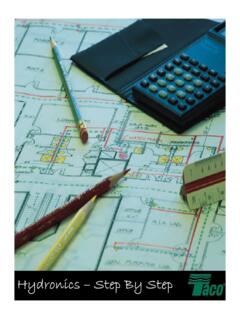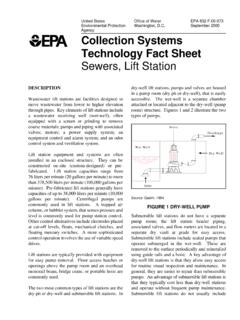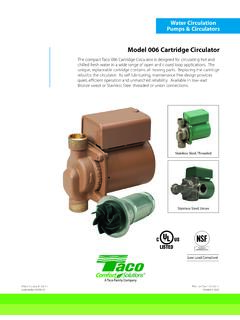Transcription of RECOMMENDED STANDARDS
1 FOR SUMP,EFFLUENT ANDSEWAGE PUMPSRECOMMENDEDSTANDARDSSUMP & SEWAGE PUMP MANUFACTURERS ASSOCIATION BOX 44071 INDIANAPOLIS, IN 46244AB INDEX PART I !PART II Definitions and !PART III Testing and !PART IV Design and ! PURPOSE OF SSPMA These RECOMMENDED STANDARDS have been established to assure users and all interested parties that sump, effluent and sewage pumps bearing the SSPMA-Certified seal will perform as stated by the manufacturer of the particular equipment involved. The Sump and Sewage Pump Manufacturers Association is composed of leading equipment manufacturers. The purpose of SSPMA is to expand the applications of sump, effluent and sewage pumps, and to promote their proper use.
2 A list of SSPMA member companies and of certified pumps is available on SSPMA s web site: 3 Sump, Effluent and Sewage Pump STANDARDS PART I General 1. Objective: The Sump, Effluent and Sewage Pump STANDARDS , adopted by the Sump and Sewage Pump Manufacturers Association, have been established in the public interest. They are designed to supply the specifier, purchaser and/or user of sump, effluent and sewage pumping equipment with definitions of equipment terminology, and a description of standard performance testing and rating protocol, in order to assist in the determination of proper application and selection of this equipment. These STANDARDS are published only for the purpose of establishing an accurate and uniform method of presenting performance data without restrictive intent or effect upon any manufacturer of sump, effluent and sewage pumping equipment.
3 These STANDARDS do not preclude any member of the Sump and Sewage Pump Manufacturers Association from producing equipment that does not conform. However, non-conforming products must not carry the SSPMA Certified seal. Manufacturers of sump, effluent and sewage pumping equipment may indicate adherence to these STANDARDS by stating in specifications and product description: Tested and rated in accordance with SSPMA STANDARDS . Manufacturers that are licensed through the Association may also affix the SSPMA Certified seal to products bearing their name or brand name, or incorporate the seal design in the description of any product to indicate adherence to these STANDARDS and procedures.
4 2. Scope: These STANDARDS provide a uniform method of testing sump, effluent and sewage pumps, as defined in Part III. 3. Marking: Sump, effluent and sewage pumps that meet or exceed these RECOMMENDED STANDARDS may be identified by the SSPMA Certified label. 4. Certification: The complying manufacturer shall be prepared to certify upon request of the purchaser that their product conforms to the requirements of these specifications and that the quality, performance or material specifications have not been otherwise misrepresented. 4 PART II Definitions and Nomenclature 1. Sump Pump: A pump powered by an electric motor for the removal of clear and/or ground water drainage from a sump, pit or low point in a residential, commercial or industrial property.
5 Solids-handling sizes of Sump Pumps are typically less than ! in diameter. 2. Effluent Pump: A pump powered by an electric motor for the transfer or removal of natural or artificial pretreated liquid waste discharge from an onsite sewage treatment device or system. Solids-handling sizes of Effluent Pumps are typically ! to less than 1 in diameter. 3. High Head Filtered Effluent Pump (Multi-Stage): A pump powered by an electric motor for the transfer or removal of natural or artificial pretreated liquid waste discharge from an onsite sewage treatment device or filtered (Septic Tank Effluent Pump) system. Solids-handling sizes of HHFE Pumps are typically less than !
6 In diameter. 4. Sewage Pump: A pump powered by an electric motor for the transfer or removal of wastewater from a sealed basin to a sewage treatment device or collection system. Solids-handling sizes of Sewage Pumps are typically 1 through 2 diameter. 5. Solids-handling Capability: For purposes of these ratings, a solid is a sphere of a stated size, plus or minus on the diameter, that will freely pass through the strainer and inlet of the pump or the inlet of the pump with no strainer, through or under the impeller vanes or a combination of both without interference with the surrounding volute housing, and out the discharge opening. 6. Grinder and Macerator Pumps (Sewage): A pump powered by an electric motor that incorporates a cutting mechanism to reduce or cut the sewage particulate size to a slurry that can be pumped through small diameter pipe to a sewage collection system.
7 7. Utility Pump: A submersible pump powered by an electric motor for transfer or dewatering applications. Utility Pumps are manually operated and handle small solids, typically less that " in diameter 5 8. Emergency Back-up Pumps: Emergency Back-up Pumps are systems or packages that are supplemental to, and work in conjunction with, a sump pump. They provide a means to evacuate water in the event that primary electrical power supply has been lost or the primary pump has failed to operate. Three types of back-up systems are typically found: (a) Low Voltage Back-up System This system consists of a DC battery-powered pump connected to a control system which maintains the charge on the battery and is activated by a level control.
8 (b) Standard Voltage Back-up System This system uses an inverter or power supply and controller to power an AC pump, using a battery as the back-up power source. Some systems may be set up to serve as both the primary and back-up pump. (c) Water Powered Back-up Pump This system uses water pressure and flow to create hydraulic energy, typically through a venturi, to draw water from the sump basin. These systems can be used only when pressurized water is available from a municipal supply or a functioning water well pump. 9. Pump Types: (a) Pedestal Type A pump in which the pumping element is located in the sump, pit or low point, and in which the motor is mounted on a tube or column extending vertically upward from the pumping element.
9 (b) Submersible Type A pump in which the entire pumping unit is located in the sump, pit or low point, and in which the motor and pumping element can be submerged. (c) Horizontal Type A pump comprised of a horizontally mounted self-priming pumping unit located at or above the floor level adjacent to a sump, pit or low point. 10. Typical Materials of Construction for Pumps (wetted components which are submerged): (a) Brass or Bronze (b) Cast Iron (c) Aluminum (d) Stainless Steel (d) Molded Material (plastic, rubber, etc.) 6 PART III Testing and Rating 1. Objective: This section is intended to provide a uniform method of testing pumps for rating purposes. 2. Types of Test: (a) Rating Performance Test The rating performance test shall be conducted under controlled conditions as outlined hereafter.
10 It is intended to be the test on which manufacturers ratings will be based. (b) Factory Performance Test The factory performance test is the responsibility of the manufacturer in order to insure that production units are within acceptable tolerance from the rating tests. (c) Field Test The field test will not be used as indication of conformance to rating unless test conditions conform to (a). 3. Total Head: Total head is defined as the actual pressure gauge reading in feet or meters of water taken on the discharge pipe with the gauge connection located as outlined under Head Measurement , and corrected by the vertical distance in feet or meters from the water level in the sump to the center line of the gauge.
